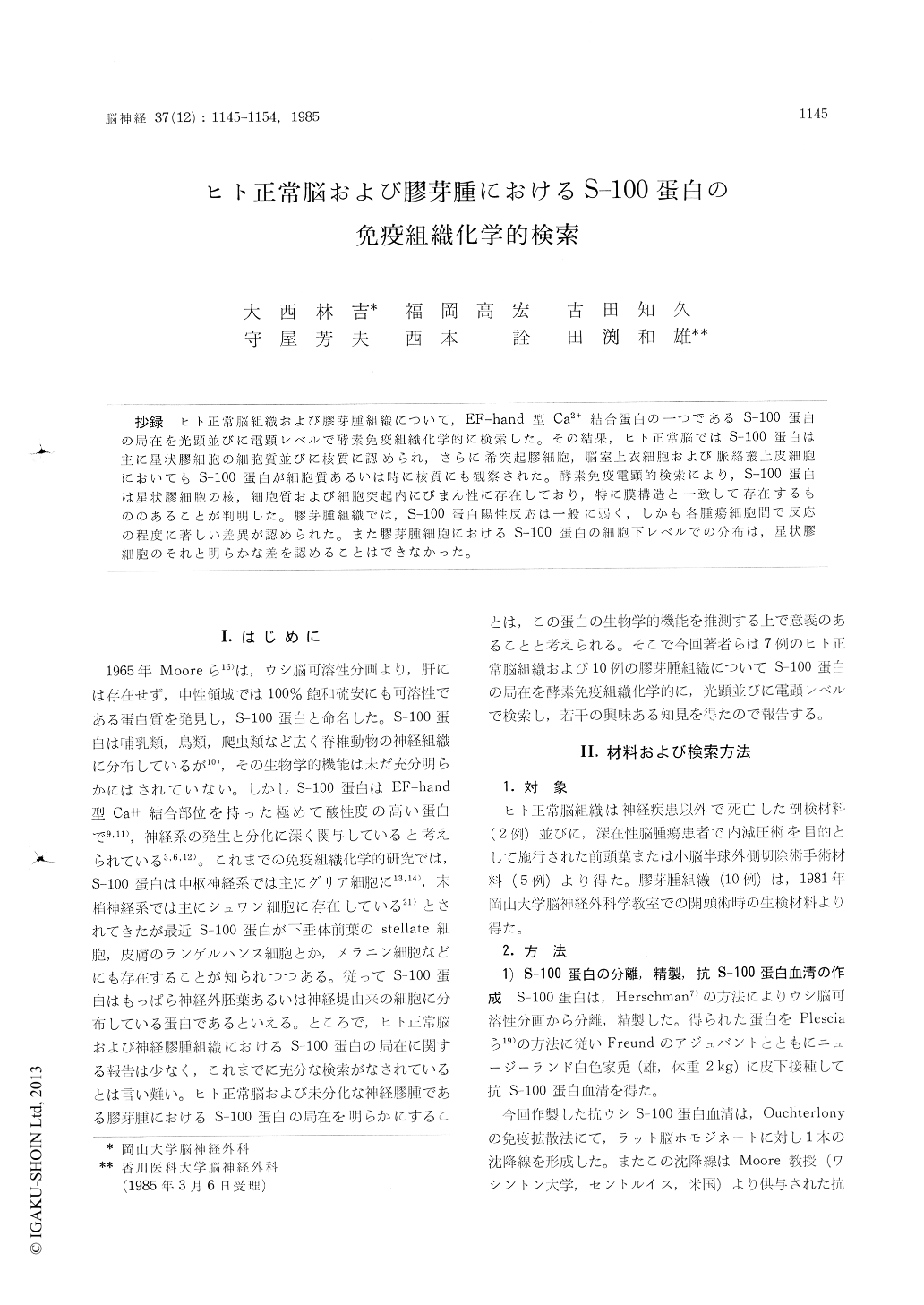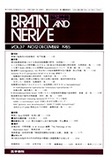Japanese
English
- 有料閲覧
- Abstract 文献概要
- 1ページ目 Look Inside
抄録 ヒト正常脳組織および膠芽腫紅織について,EF-hand型Ca2+結合蛋白の一つであるS−100 蛋白の局在を光顕並びに電顕レベルで酵素免疫組織化学的に検索した。その結果,ヒト正常脳ではS−100蛋白は主に星状膠細胞の細胞質並びに核質に認められ,さらに希突起膠細胞,脳室上衣細胞および脈絡叢上皮細胞においてもS−100蛋白が細胞質あるいは時に核質にも観察された。酵素免疫電顕的検索により,S−100蛋白は星状膠細胞の核,細胞質および細胞突起内にびまん性に存在しており,特に膜構造と一致して存在するもののあることが判明した。膠芽腫組織では,S−100蛋白陽性反応は一般に弱く,しかも各腫瘍細胞間で反応の程度に著しい差異が認められた。また膠芽腫細胞におけるS−100蛋白の細胞下レベルでの分布は,星状膠細胞のそれと明らかな差を認めることはできなかった。
The authors investigated the immunohistoche-mical localization of S-100 protein in normal hu-man brain and glioblastoma tissues by the pero-xidase anti-peroxidase method of Sternberger. In normal human brain the positive immunoperoxidase reaction for S-100 protein was observed in astro-cytes, oligodendrocytes, ependymal cells, Berg-mann's glial cells and epithelial cells of choroid plexus. No positive staining was revealed in any cortical neurons. Immunoelectron-microscopically, the electron dense positive reaction for S-100 protein was seen throughout the cytoplasm, nu-cleoplasm and cell processes of astrocyte as well as oligodendrocyte. The positive reaction for S-100 protein was demonstrated occasionally in association with cytoplasmic membrane or the membrane constituting cell organelles. We sus-pect that this observation indicates the existence of membrane-bound form of S-100 protein. In glioblastoma cells, the positive reaction for S-100 protein was relatively weak in intensity as com-pared with astrocytes, and the degree of positive staining varied from cell to cell. Subcellular localization of S-100 protein in glioblastoma seemed to be essentially similar to that of normal astrocyte. There are some recent reports concern-ing immunohistochemical localization of a and ie subunits of S-100 protein. As compared with these reports, the present immunohistochemical results indicate that the rabbit anti-S-100 antibody embloyed in the present study is mainly against β subunit of S-100 protein. Although there have been many reports concerning immunohistochemi-cal localization of S-100 protein, the biological role of 5-100 protein is still speculative. Some hypotheses are advocated in connection with the possible biological role of S-100 protein. For example, the modulation of synaptic transmission by S-100 protein, the participation of S-100 pro-tein in hormonal secretion and in transport of cations through lipid membrane, the activation of protein kinase and the promotion of disassembly of microtubules by S-100 protein are postulated.It is hard to assume the biological role of S-100 protein based on the immunohistochemical results alone. The present study clearly indicates that S-100 protein exists widely in the cytoplasm, nucleoplasm, cytoplasmic membrane, outer mem-branes of cell organelles and cell processes ofglial cells as well as glioblastoma cells. From these results we assume that S-100 protein plays an important role of intracellular transport of cations as one of the calcium binding proteins.

Copyright © 1985, Igaku-Shoin Ltd. All rights reserved.


